Most of the time I LOVE my job, and one of my all-time favorites is when I am able to help kids overcome oral defensiveness.
It is so extremely satisfying when kids are able to eat and enjoy healthy foods that were previously off the table, so to speak. Who are these kids and why is eating difficult for them? There are so many answers to this question. I have worked with children with sensory processing disorder, autism, ADHD, oppositional defiant disorder, anxiety disorder and post-traumatic stress disorder. These kids might show only mild symptoms of the conditions above, but end up having difficulty eating ordinary healthy foods with their families and friends.
Cautionary Note: before starting food therapy it is important to get a good food history and baseline data, rule out oral-motor and swallowing dysfunction, and join forces with the child’s family to prioritize food goals. Also note that there are two main approaches to sensory-based eating difficulties. Here is a great article on play versus behavioral approaches to overcome food aversions: http://www.otplan.com/articles/strategies-to-improve-feeding-at-home.aspx
This year I have had the good fortune to work with a batch of kids that have needed to expand their food intake. I thought I would briefly describe three children and the types of play activities that have been helpful for them to gain confidence and pleasure with eating a greater variety of foods. Please meet David, Emily, and Alex:
David is a three-year-old student in an early childhood classroom. He has always had difficulty with weight gain and all his developmental milestones have been delayed. David eats only crackers and chips at school. He has a strong tactile and oral aversion to anything that is wet or slippery. He has a difficult time with getting paint or glue on his hands.
My approach with David is pure sensory exploration. I took several photographs of one of our sessions, and his parents have graciously allowed me to share them with you. I remove everything from the environment except for the one food we are playing with. In this session we have a container of diced peaches and a small plastic plate from the kitchen area of his classroom. He is familiar with the containers, and likes to play kitchen. I model picking up a piece of peach and pretend I am feeding a dinosaur, because David loves dinosaurs.
|
|
David
1.
At first he is reluctant to touch the peaches you can see how he extends his fingers to make as little contact as possible. But there’s not much else to do, it’s just us and peaches. |
|
|
2.
He has quickly gotten used to picking them up with his right hand, and is starting to use his left hand to hold the container. |
|
|
3.
When first using his left hand to touch the fruit, it is like starting over from the beginning. Note his extended fingers again! |
|
|
4.
Then he becomes able to pick up the peaches with his left hand too. Now playing with peaches has become a crossing the midline and a bilateral task.When he has filled up the little toy plate with a pile of peaches, I discreetly toss the peaches in the garbage, and we start again, “feeding the dinosaurs”. |
|
|
5.
David starts to be interested in looking at the peaches.I start talking about kissing the peaches, and VICTORY, soon David starts to explore them with his lips and tongue.He is in control, I do nothing more than give a verbal suggestions, and model for him what touching the peaches to my lips and tongue look like. |
|
|
6.
He was so happy and content playing the peaches, that I pulled out a container of pineapple and we started playing with that too. |
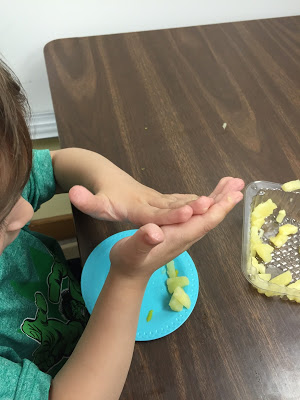 |
7.
He had gotten so comfortable with the wet, cold textures that he started rolling the pieces of fruit between his hands.
|
 |
8.
More quickly this time, David becomes interested in tasting pineapple too!GO David!
|
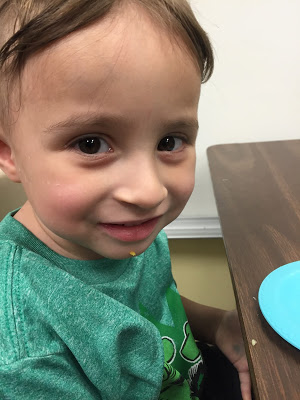 |
9.
He left happy and content, and felt successful. I consider this a highly successful therapy session, even though all we did was to play with fruit for 30 minutes! |
Emily: Next I would like to introduce a four-year-old girl, who developed typically for the first years of her life, and then at two years, was diagnosed with cancer. She had numerous hospitalizations and medical interventions and while she was being treated she lost her appetite. She was given a G-tube [Gastro-intestinal feeding tube] to maintain her nutrition and strength. Now she is at home, and is medically stable. Not surprisingly, probably in response to her difficult medical interventions, Emily now has significant tactile and oral aversions. On good days she’ll eat a few crackers and a few bites of rice.
I used the Food Survey for Oral Dysfunction, Sensitivity, Food Aversions, and Nutrition to interview mom and get detailed information on the foods Emily is willing to try, and which ones she seems to like. When asked about food priorities, mom indicated that she would love for Emily to be able to eat fruit. Mom said she remembered Emily loving fruit, and wanted her daughter to be able to have that pleasure again. Truthfully, if I had been working with Emily in the school setting, I would have approached building her sensory tolerance to a fruit through touch and play much like I did with David above. But I was not seeing Emily at school, I was going into her home, working side-by-side with her mom. As Emily’s mom also showed evidence of tactile defensiveness, and had a strong desire not to give Emily any difficult task, I had to come up with a different approach.
|
|
It turns out that Emily loves small manipulative toys. I have found that I can give her one gem which she pushes through a slot before it drops into a container. Coaching mom to place the smallest sliver of fruit on the spoon, Emily will take a taste in order to get the next gem. During our first ‘food’ session, Emily ate a quarter of one banana, one teeny piece at the time.
|
Her mom was elated, saying that it was the first time she ate bananas in over two years. Now Emily is happily eating bananas and apples on a regular basis. She has a good start on potty training, and now we are also exploring some strategies to help make tooth brushing be more pleasant!
Alex is a five-year-old kindergarten student with autism. He is new to OT and when I evaluated him I saw that he was eating only fish crackers at school. His parents were interested in expanding his food repertoire and have been very helpful in sending a variety of table foods from their home, as well as new kid-friendly foods to school. I scheduled Alex for OT two times a week during his lunch period, as he was refusing to eat anything while in the school lunchroom. I decided that we would start with foods he did eat, and liked to eat at home, but was not willing to eat at school. Alex is a boy who has a STRONG will. When he says no, he means it. My hunch with him was that we needed to have a structured session and that the authority needed not to be me but “the schedule.” This
visual schedule reflects our routine. He comes to OT with his lunch, and before doing what he wants to do [write letters starting on the iPad] we start with his main dish.

My first session with him, I used my teacher voice to say that the spoon picture meant that he needed to touch the spoon that had been in his noodle dish to his lips. The moment he did that, I proclaimed his action a smashing success, and we went on to our first task. We went back to the spoon after every preferred task, but he knew he only needed to put the spoon to his lips so he did it quickly and we got on famously. In every subsequent therapy session I have upped the ante a little bit. Next, I had him touch his tonge to his spoon, then clean the spoon between his lips, then clean the spoon with one noodle, the next time he was eating a few noodles at the time, and then a few bites. Most recently he took it upon himself to finish his main dish before we started our first preferred task!

What I have not said is that I modeled every step. I had my lunch at hand, we talked about it, smelled it, and I showed him what I needed him to do with my own spoon. When he started cleaning his spoon, it was after he watched me clean my spoon with my lips. When I wanted him to take several bites, I would have a turn, and then he would have a turn. The spoon in this picture has been the symbol to represent eating on the therapy schedule. The symbol has remained the same, despite the increased expectations. I was able to give an identical spoon picture to his paraprofessional, and now Alex is now beginning to eat his lunches in the lunch room too! If you would like to read more about using visuals for occupational therapy this link will take you to
my blog post on making and using visual supports.
You can find the two products that were used in therapy for these three kiddos here:

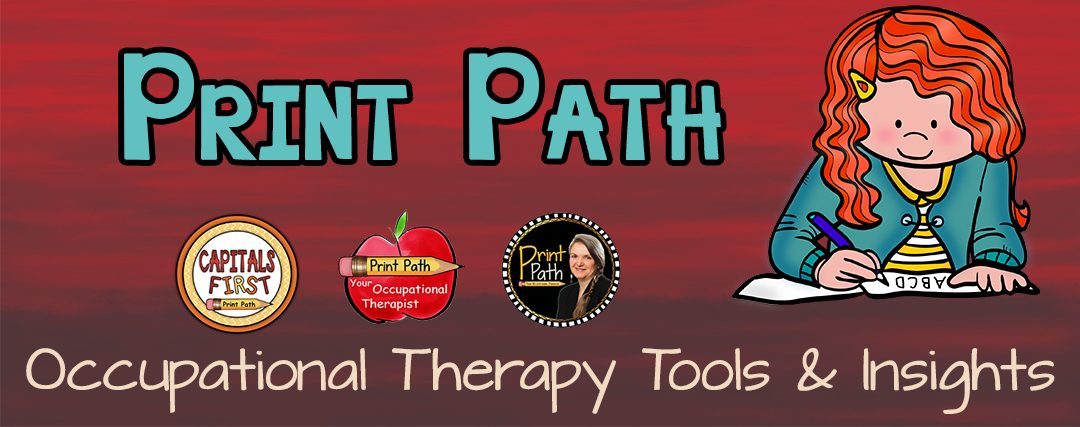
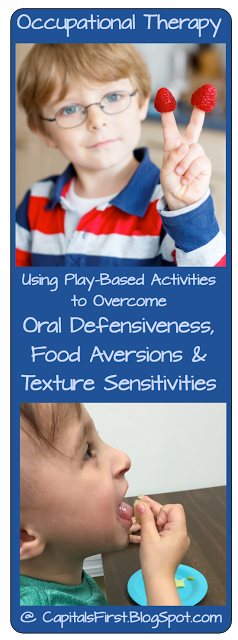
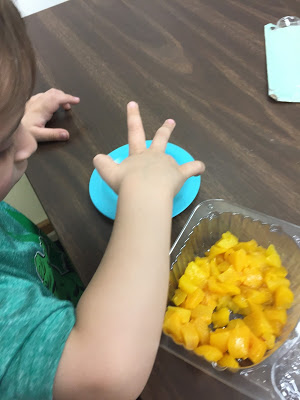
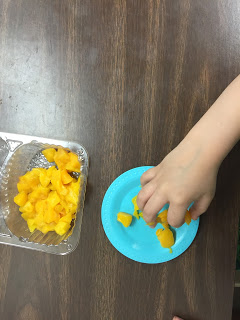
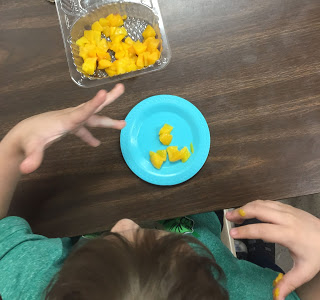
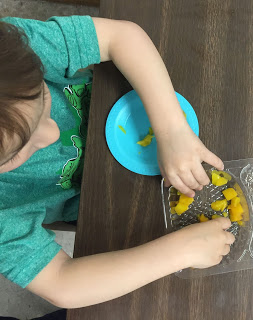
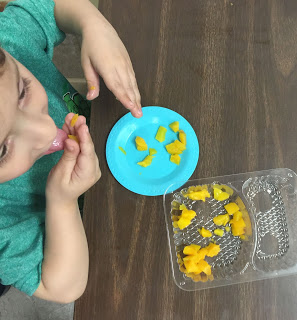
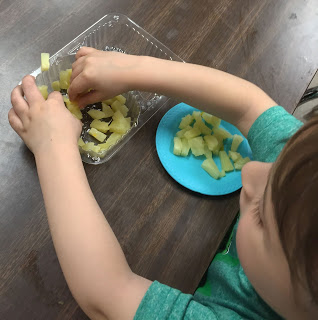



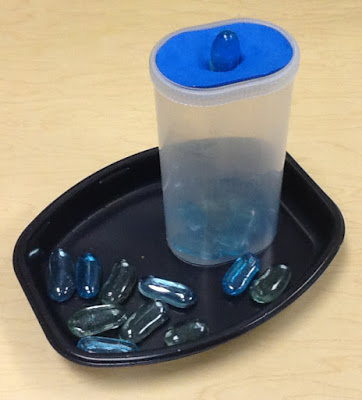


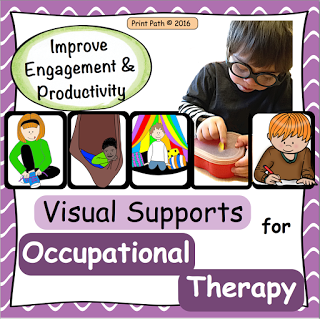
Excellent article! I’m sharing with our therapist’s an parent’s via our Facebook page.
This is a very informative post providing useful ideas for both parents and professionals on ways to treat oral defensiveness!
Informative post! It is wonderful to see the progress your students have made. As an SLP, there are great ideas here for cotreatments. Thank you for the terrific links; I will be passing along your post to parents as well as other professionals!
Great information and ideas. Thanks